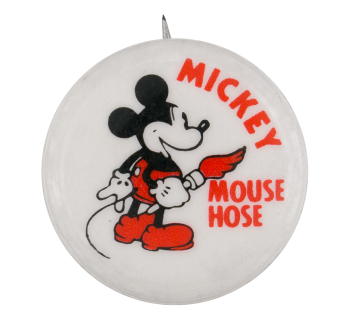Mickey Mouse Hose
| Category | |
|---|---|
| Additional Images | |
| Sub Categories | |
| Text on Button | Mickey Mouse Hose |
| Image Description | A cartoon illustration of Mickey Mouse with a white background and red text. |
| Curl Text | ©Walt Disney Enterprises |
| Back Style | |
| The Shape | |
| The Size | |
| Year / Decade Made | |
| The Manufacturer | |
| Additional Information | After the initial success of Steamboat Willie in 1928, Walt Disney created new partnerships to sell merchandise of his characters. His first major partnership, in 1932, was a 50/50 split with ad-man Herman "Kay" Keman. Keman licensed Mickey Mouse for a variety of products including home goods, toys, and clothing, to be sold nationwide through department stores and mail-order catalogs. Childrens' socks and stockings were branded as "Mickey Mouse Hose" and were offered in different sizes, lengths, and colors. Mickey Mouse Hose had imagery of Mickey Mouse on the heel, toe, or cuff. Some designs were reproduced in the 1970s or 1980s. |
| Catalog ID | AD0699 |



